Pickin - his moments

The Phoenix Sports & Social Club is a green oasis in industrial south Yorkshire. Surrounded by business units and housing, with the M1 motorway just a mile away, the club began life as a sports facility for the employees of the Rotherham steelworks of Steel, Peach and Tozer.
As time passed and the club's popularity grew, the facilities were increased and improved to incorporate a clubhouse and to cater for many different sports.
As the numbers employed at the steelworks gradually diminished, the facilities were opened up to local residents until today, as a Social Enterprise Organisation, the club offers its facilities, not only to local steelworkers, but to the public as a whole, for sport, recreation and for functions.

This 6181 yard, par 71 course has a strong membership and vibrant junior section that would be the envy of many top ranked clubs. It is certainly no 'afterthought'.
In 2011, the club was presented with Golfmark and Clubmark accreditation, which is seen as the final seal of approval from England Golf and Sport England.
So, where to start?
The site covers a total area of sixty hectares, of which forty-two provide the golf course, with five used for football pitches. The remaining hectarage includes the cricket facilities, bowls green and driving range.

He joined the army at the age of fifteen and served into his twenties. "I joined the Junior Leaders in Canterbury and, after graduating, joined the 2nd Battalion Light Infantry in Germany. I also served two tours of Northern Ireland and was awarded the General Service Medal."
On leaving the army, and having an engineering/welding fabrication qualification, Graham set up his own horticultural engineering business (Barnsdale Mowers) where he serviced and repaired all manner of mowers, strimmers etc. His first greenkeeping job was as assistant at the Mid Yorkshire Golf Club. "From there, I went to Thornhurst Park in Doncaster, where I was eventually appointed Head Greenkeeper and, after gaining an HNC in Golf Course Management from Elmwood College, was appointed Course Manager. Incidentally, I was Elmwood's nominee for the Toro Student Greenkeeper of the Year award. I was also a successful candidate for the BIGGA/Bernhard visit to the GCSAA show in Orlando."

Other training and education that Graham has completed include C&G Engineering (Wakefield Tec), PA1, PA2 and PA6a (Askham Bryan), Cricket Maintenance & Renovations, Briggs & Stratton warranty courses, a Hayter maintenance course and PAT testing.
Graham joined the Phoenix just over two years ago and, as well as team of five highly experienced greenkeepers - Adi Glossop, Steve Cruise, Dave Maude, Mick Parry and Mark Smith - who, between them, have 117 years of knowledge, he is the manager/coordinator for eleven artisans, each of whom works four hours per week performing various tasks and have their membership fees adjusted accordingly.
"This means that I get two every morning, whilst one works evenings; 104 hours each over twenty-six weeks. The system works a treat. They get an insight into our daily working lives and also learn new skills."
Graham describes the soil across the site as clay/loam which generally just requires standard aeration techniques, although several areas have drainage issues which he and the team are addressing. "I have prioritised these areas and started installing drainage schemes that have been designed by myself."
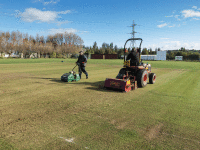
"The cricket square has ten strips. Each wicket lasts two weeks, thanks to verti-cutting, cutting and rolling. The square is kept at 10mm using either a Ransomes pedestrian or a Toro 3100-D and wickets are cut out to 5mm using a Ransomes pedestrian."
"The square gets regular light foliar feeds and each wicket gets a light renovation after its two week stint, with an overseed and a light dressing of Boughton County loam."
Graham undertook his first ever cricket renovation last September; "It went quite well, I think!" he confesses. "All processes were undertaken within the same day and the lads worked very hard to complete it, as did our artisan, Ken. We cut the square at 5mm and triple verticut to remove organic matter from the crown up. This was followed by a deep scarify with a tractor mounted unit to 13mm deep to remove organic matter within the rootzone (three passes). After clean up, it was overseeded with dwarf rye and an organic pre-seed fertiliser was put on. Finally, it was topdressed with County loam."
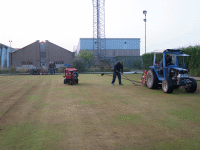
As you might imagine, the bulk of the team's work revolves around the forty-two hectares of golf course. "Presentation is only second to turf performance," states Graham. "I am a bit of a stickler where presentation is concerned, but you have to be realistic in expectations; workload, weather and manpower all have an impact."
"Fortunately, I have very experienced staff and, whilst each person is capable of any task, I like to give them tasks that they are comfortable with and are good at, because it shows in the finished product. It also makes best use of their time."
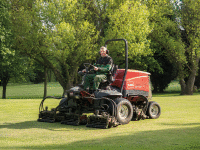
"At this time of year [May], the greens are cut at 3.5mm. They get a bi-weekly verti-cut using our Greentek Thatch-Away units, sarrel rolled and topdressed with Mansfield MM35 sand. Light and regular foliar feeds are applied. Controlled release fertilisers are used on tees, aprons and surrounds. During the autumn and winter, I apply monthly turf hardeners, like irons and phosphites, to great success, plus seasonally selected forms of N, such as Potassium nitrate, in the winter."
Since Graham's arrival at the club, a number of projects have been undertaken to improve both shade and air flow around greens and to get water off the course and in other problem areas around the site.

"This required a programme of pollarding, as well as removing some trees altogether," states Graham. "It is important that the members are kept informed about the whys and wherefores of what we are doing and, to that end, I write a regular blog for the website explaining the processes. I do try and add some humour as well."
"Having the artisans assisting us with these projects is very helpful, but they can also relay their thoughts back to the members."
"We have successfully drained a very problematic 11th Par 3 and 12th tee area, and constructed a new tee with full decoder auto irrigation.
We've also extended paths in several locations and have some exciting plans for the future, including further drainage and construction projects."
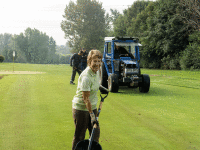
"I have been using phosphites and other elicitors against microdochium with great success, historically we have suffered from anthracnose (foliar) but, with my de-stressing programme, I am making serious headway with this recurring problem."
"And then there are the foxes!" bemoans Graham. "They were constantly digging up the greens. To date, we have dispatched over sixty-five in the past twelve months and now it is under control. We use a police approved, certified marksman with an open licence."
"At my previous club, we had an environmental policy and, whilst we don't currently have one in place here, it is in my plans to create one.

"I am considering rainwater harvesting to supplement our water source. Future projects will recommend installing bird box. At my last golf club,
I put up 200 boxes, which were made and installed by the local special needs school, and we witnessed an explosion in the Tit family."
"We still have lots of planned work for next winter, including all the machinery to repair and service. Let's hope Santa brings me some new spanners or a bottle of Rioja. I'm not bothered which."
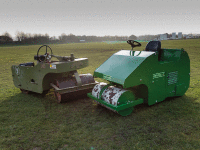
Toro 3250-D Greensmasters x 2
Toro 4700-D Groundsmaster
Toro 5510 Reelmaster
Toro 3100 Reelmaster
Iseki tractors x 3
Sisis topdresser, slitter, sarrel roller
Ransomes pedestrian mowers x 3
Jacobsen AR 522 rotary mower
Jacobsen Tri-King triplex
Wiedenmann TerraSpike
Poweroll 12
"To be honest, how we purchase machines has been a bit of a mishmash, but I'm working on it. Basically, it has been anybody who can supply what I want at the right price, whether that be new or secondhand."
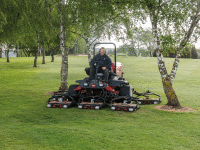
I'd like to add a Graden CSI, which is a fantastic machine and, also, although I haven't used it yet, the Air 2G2 looks exciting. Any machine that removes thatch and aerates is worth looking at, but there's a lot of chaff around.
We hire in mini diggers, but have our own operator in Mick Parry.
Servicing is undertaken by myself (when I have the time) and Mark Smith.
My wishlist would include a Toro HDX-D Workman and a Toro Propass. A further Toro 4700 - we have a lot of grass - would be useful. A Charterhouse Verti-Drain 7316 wouldn't go amiss either."
